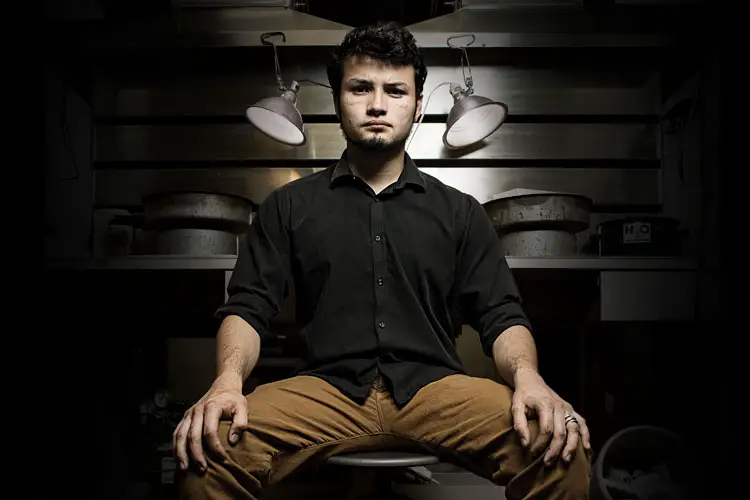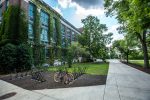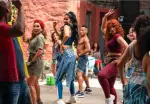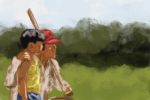Student and artist Josue Romero is putting the finishing touches on a new piece. “The assignment was to make a piece based on historic jewelry or costume,” the Southwest School of Art (SSA) sophomore explains of the almost-finished product, a metal mask reminiscent of a Corinthian warrior helmet. That’s not the only thing familiar about the mask, though.
Looking at the piece, other recognizable shapes quickly begin to jump out. Europe trails down one side of the warrior’s face, while above it Africa and North America meet to protect his forehead and the tail of South America hangs down between his eyes.
“I was considering taking the outlines of countries and putting them all together,” Romero says of his initial vision for the piece. “But at some point, I decided it was a better idea to take the outlines of the continents, because rather than accentuate these arbitrary borders that we’ve placed upon the planet, or upon our maps anyway, it would make more sense to cut out the natural shapes that are just part of the world, that are there but don’t separate us.”
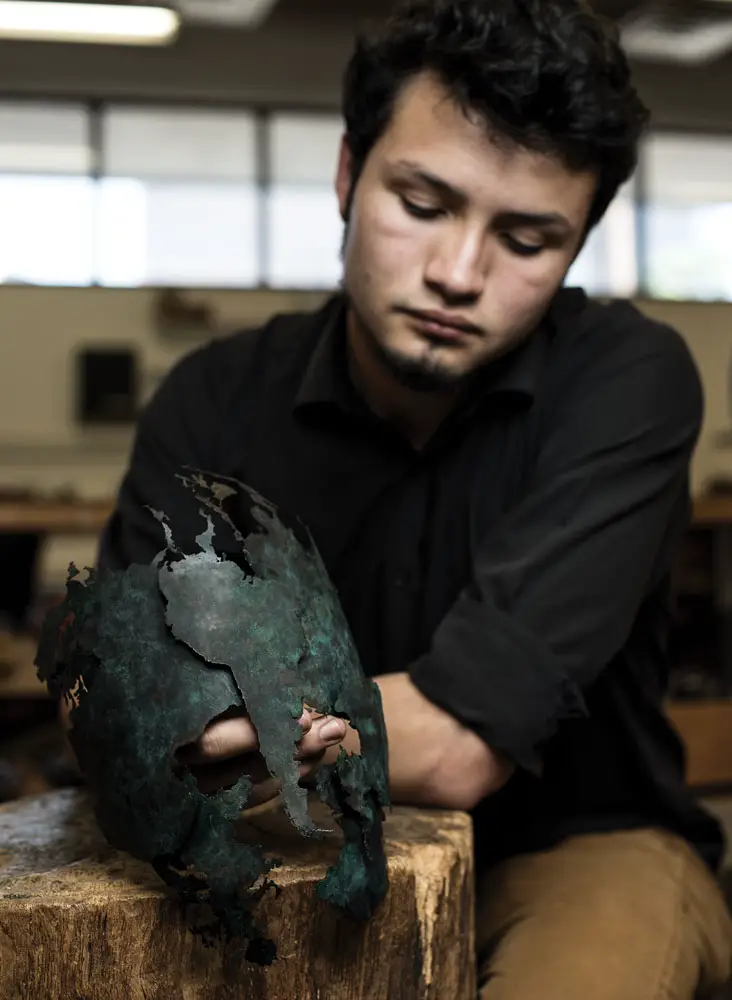
For Romero, art is not just a means of expression, but a process of understanding, a way to make sense of the world. “A lot of my work has to do with self mapping and self discovery,” he says. When this project was assigned, Romero had a lot to make sense of.
“I wanted to do a piece in light of everything that’s happening. I decided I wanted to do it about unity and togetherness in terms of what happened. Usually I haven’t touched on political issues much, if at all, but now I feel like it’s kind of impossible not to.”
The inspiration Romero refers to is his detainment and threatened deportation by the United States Immigration and Customs Enforcement (ICE) earlier this year. The Honduras native and San Antonio resident, who has lived in the United States since he was four years old, is a beneficiary of the Deferred Action for Childhood Arrivals (DACA) program, and made headlines back in February following his highly controversial arrest, ICE detainment and release.
Initially arrested for possession of less than two ounces of marijuana, Romero’s nightmare began the way many do—being in the wrong place at the wrong time, barely. The night of his arrest, Romero was leaving Guadalupe Martinez Park just before its 11 p.m. curfew, when he was stopped by police. “I figured it was because of curfew,” he says. “Looking at the time, it was around 11:01 at that point.”
After police searched the car, Romero was taken into custody of the San Antonio Police Department before spending the night in jail. “I still was not too worried at that point,” Romero says. He placed a phone call to his dad, and the next morning signed a bail bond. All signs pointed to a quick release, until Romero was approached in jail by ICE officers.
“They went around the detention cell and asked people their name and country of origin,” Romero says. “I knew they were looking for me specifically; they seemed to know. They asked me specifically if I was from Honduras.”
Romero’s intuition regarding the ICE officers is not unfounded. “We do not know what specific mechanisms are in place with either the San Antonio Police Department or the Bexar County Sheriff’s Department to facilitate their collusion with ICE, but we do know that collusion is happening, and it is aggressive,” says Amy Fischer, policy director for RAICES, a non-profit organization providing support and legal services to refugees and immigrants.
Says Romero, “I asked if, being that I had DACA, I would be alright. I was supposed to be protected from them, but they told me that I wasn’t, and that I wouldn’t get a chance to fight. That struck me as a little bit odd. But they told me I wouldn’t be getting released to my dad; I would be taken into their custody.”
From there, the SSA student was taken to an ICE detention center Thursday morning, February 16. Romero described the location as seemingly new, or just recently built. All the paint was pristine and clean, and there was no mess. While a clean facility may, under most circumstances, have been welcomed as a small source of comfort, for Romero, it was an ominous symbol of another recent change. “I did get it confirmed by my lawyer that it was recently built, probably along with the changing of administration,” he says, leaving the implications of that discovery to speak for themselves.
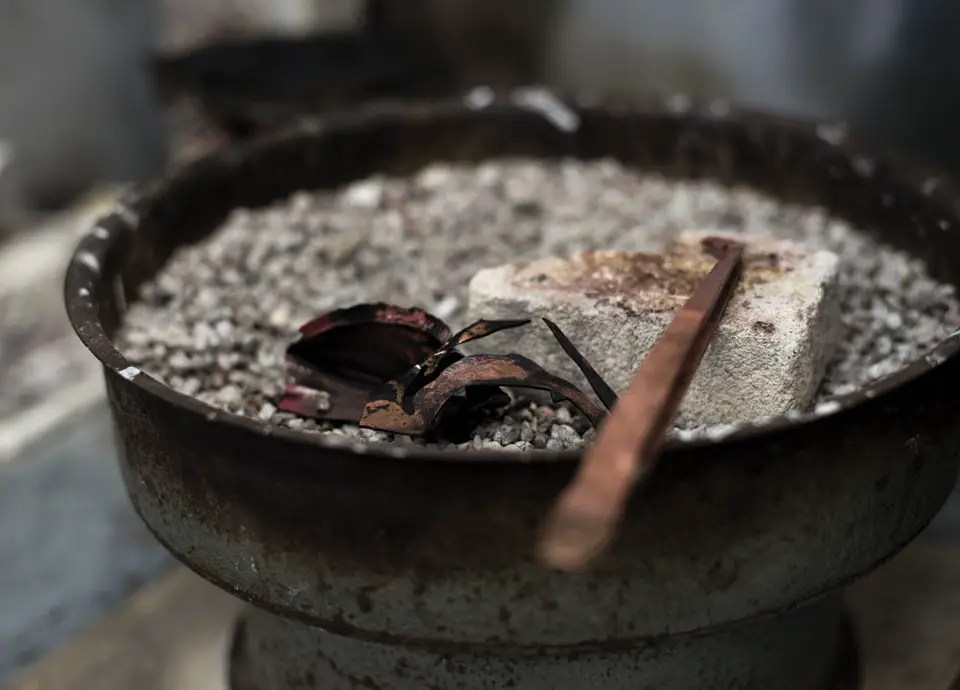
Romero was one of the first to be processed, and recalls the moment as the one in which he was finally forced to accept his nightmare as reality. “Up until that point I had been really hopeful that I could fight my case. I was a student; I’ve been here my whole life; I hadn’t done anything wrong before. But they basically told me I wouldn’t get to fight my case, that I would just be on a plane to Honduras within the next week. At that point, my heart did kind of sink,” he says. “It kind of solidified. I would be losing all my friends, my family and my whole life. At that point it really seemed real, like it was going to happen, and there was nothing I could do about it. And that’s basically what the ICE officer was assuring me.”
Awaiting transportation to Pearsall Detention Center, from where he expected to then be deported to Honduras, Romero was permitted to make a few phone calls. Margaret Fitch, Romero’s mentor at the Southwest School of Art and a ceramics student in the school’s adult community program, recalls being the recipient of one of these calls. “I asked him if we would be allowed to visit him at Pearsall to bring him a suitcase of personal items to take to Honduras with him, because he had nothing with him except the clothes he was wearing at the time of his arrest. He asked for a few items of clothing, shoes and a sketchbook with pencils.”
Fitch has been working with Romero since spring 2015, when they met through the school’s mentor program. She recalls being immediately impressed by his maturity, deeply creative mind and his enthusiasm for working hard toward his goals. During this difficult and unforeseen phone conversation two years later, Fitch did everything she could to remain a mentor.
“I tried to be positive and cheerful about the prospect of his deportation back to the country where he was born and lived as a baby, but actually knew nothing about. I suggested, as a worst case scenario, that he could perhaps enroll at either the University of Honduras or the University of Costa Rica and return in two years to San Antonio as an international graduate student” she says.
While laughing and crying at the same time, she assured Romero that those universities have excellent fine arts programs. “This may be an opportunity in disguise,” the mentor remembers saying through tears.
Behind her positivity, however, Fitch was livid. “The blatant injustice of the whole situation was shocking,” she says. She lambasted the Trump administration for its flash-in-a-pan immigration policy, blaming situations like the one with Romero on politicians who are fixated on headlines rather than sustainable, intelligent litigation.
“I blame the current political regime for causing this traumatic situation to a 19-year-old who had absolutely no power to choose his fate, either when he was brought to Texas when he was four years old, or at the present moment when he was dragged into a detention facility by a kangaroo court of a government agency attempting to crack down on ‘illegals.’”
According to Fitch, the manner in which his detainment occurred was, indeed, the manner in which fascist governments behave. Fortunately, Fitch wasn’t the only one incensed by Romero’s situation. Due to the quick action and the intervention of the community, including RAICES and Congressman Lloyd Doggett, Romero was released back into the San Antonio community Thursday evening, two nights after his initial arrest.
“We were on the way to Pearsall when the van turned around,” Romero recalls. “They seemed to get a call, and the van turned around on the highway and went back to the same detention center. When we got back, they called out my name and released me. They told me I was getting released on an order of supervision. They made me sign, and they asked me to call somebody to pick me up, and then they shoved me out the door.” By February 23, the order of supervision had been lifted.
In a statement issued February 16 petitioning for Romero’s release, Congressman Doggett urged the community to unite on Romero’s behalf. “I hope other members of our community will join in voicing their strong support for Josue,” the statement concludes. The San Antonio community seems to have risen to that challenge.
“Without the support of the community, Josue would surely have been detained and could be facing deportation still today. This is a victory for our community,” says Fischer. The support did not stop with Romero’s release. In the aftermath of the incident, Romero has continued to feel the warmth of support from friends and strangers alike.
“It wasn’t just school, it wasn’t just my friends. It was people that I hadn’t even met before who were willing to support me. We all felt it together as a community,” he says.
Romero remembers an encounter in a restaurant with one such community member. “My dad and I were just having lunch and somebody recognized us and they paid our bill. My dad and I sat there after they had left and were kind of bewildered but really grateful—not only for that but just for the love people were willing to show.”
For Romero, community is the answer, and not just in his case. “This experience didn’t just affect me. It’s affecting the whole community, and that’s the only way to fight back. The only way to really become stronger and fight these times is to stick together and show each other love and appreciation.”
Romero also urges members of the community to remain vocal, regardless of their immigration status, crediting his father’s initial willingness to reach out to the local news station as hugely influential in his release.
“It’s hard because it’s counterintuitive,” Romero admits. “But fear also builds with not wanting to speak. We never feel comfortable talking about it, and even less so when something terrible does happen. I’m really grateful that my dad was smart enough to reach out. That’s how the lawyer found out, and how other people found out. I would encourage other people to do that as well, to be vocal.”
Due in no small part to the outpouring of community support, Romero sees his future in San Antonio. “Of course I want to travel,” he says. “A big part of being an artist would be exhibiting my work in different places and experiencing other cultures, but I do see my future as being part of the San Antonio community.”
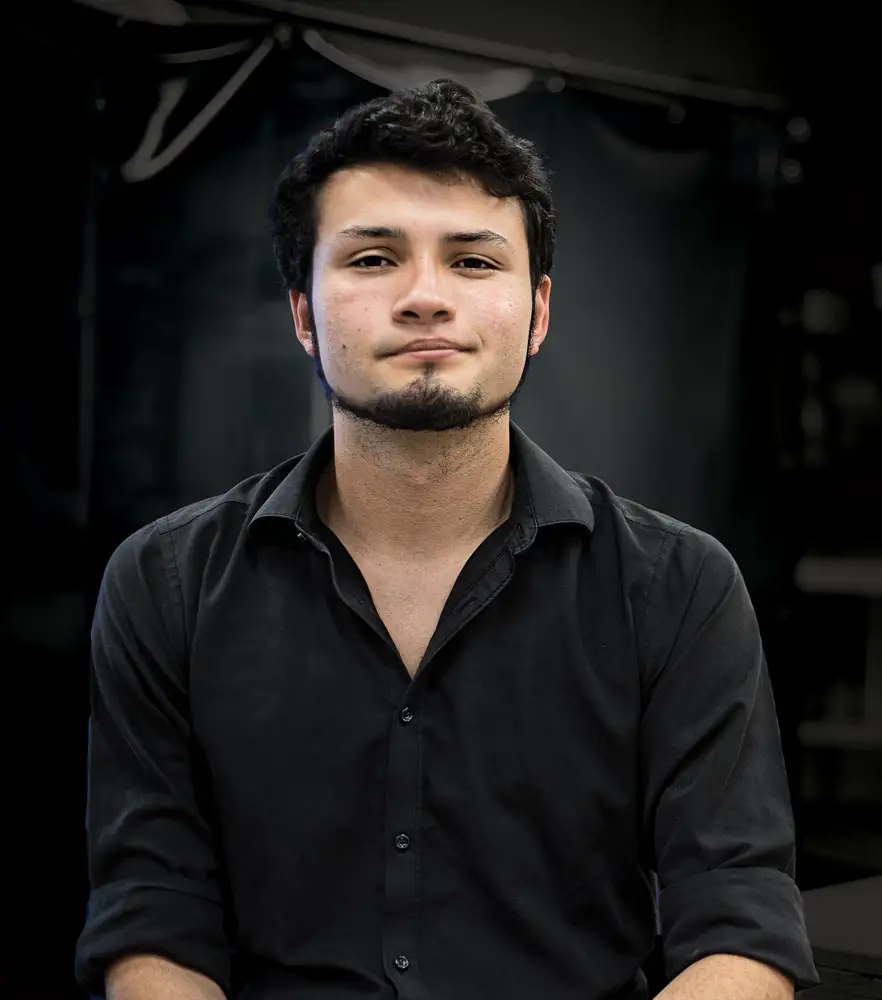
And by all accounts, that future is a bright one. Tommy Hopkins, a former program director at Say Sí, a non-profit program that provides tuition-free arts education for students starting in middle school, has known Romero since he was an eleven-year-old boy just starting out in the program. Even at this young age, Hopkins remembered Romero as inquisitive, enthusiastic and eager to push his own creative boundaries. As the young man continued to excel during the program, he became a mentor to younger students and later an ambassador for the program.
Of the arrest and detainment, Hopkins maintains that Romero handled the situation as only the best of us can—poised and collected, respectful and thoughtful, and with sincerity and gratitude. He, too, extended his gratitude to the community for their efforts in Romero’s release. “Josue is a driven and motivated artist that will continue to contribute to the artistic community in San Antonio,” he says.
While Romero has proven himself an indispensable member of the community, he insists that his achievements do not make his case special. “Most of the people that are being targeted through these policies aren’t criminals. They are not terrible people. In my case, I’m just a student trying to work really hard to appreciate opportunities that I wouldn’t have had in Honduras,” he says. “Even the people that don’t have DACA are still really active members of the community; they still have a positive impact.”
Fischer espouses similar sentiments regarding DACA. While she maintains that, as a DACA recipient, Romero should never have been in ICE custody, she remains adamant that DACA does not make anyone more deserving of support than any other immigrant.
“There are not good immigrants and bad immigrants. Immigrants—all immigrants—make our community stronger,” she says. “We have seen ICE aggressively target our community over the last few weeks. RAICES is ready to fight back.”
And so is Romero.
“That’s how I settled on the warrior mask,” Romero says of his latest piece. “It’s the idea that even if you’re considering unity and peace and wanting to bring everybody together, in light of all that’s happening, you can’t just sit back; you have to be willing to fight. And maybe not in a violent way, but you have to be willing to fight on behalf of these things that you consider correct and right and just. I really wanted this piece to speak to that. And I feel like its successful.”
While the piece may be almost finished, the fight is just beginning.
“It will definitely go on past my lifetime and any of ours,” Romero says. “But, I’m very hopeful about it. I like to be optimistic anyway.”


